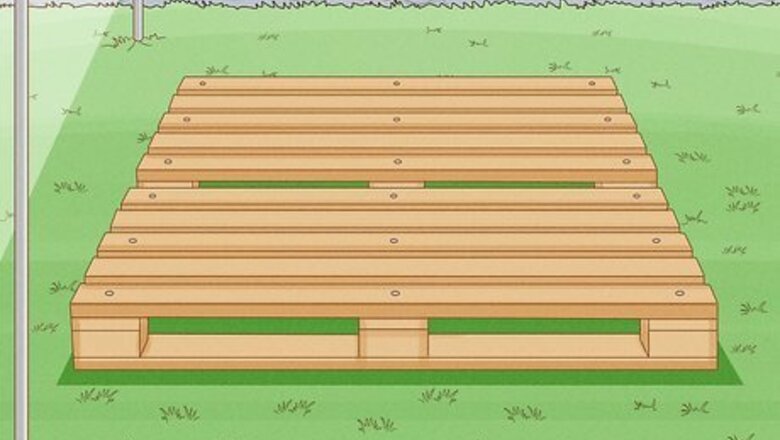
views
Moving the Bales to the Pallet

Arrange your pallets in an accessible area. Your stacks need to be easy to get to, so choose a place you can access without difficulty. Avoid stacking bales directly on the ground. The hay will soak up moisture and become moldy. To prevent this, use wooden pallets as the foundation. You can also use old tires or telephone poles to build your stacks on, but pallets are the easiest and most common choice. Consider covering your pallets with a tarp for an extra layer of protection.

Grab the bale by the strings with both hands. Put one hand around each string. This work is tough on your hands and sometimes hay can be thorny. Wear leather gloves or use hay hooks if you're moving a lot of bales.

Lift with your legs rather than your back or arms. Stand with your feet shoulder width apart, bend your knees and lower yourself to the ground. Keep your back straight and your abs tightened. Lift the bale with power generated by your legs. Then, lean the bale against your pelvis as you carry it to the stacking area or to the next person. Lifting bales with your arms and back can cause strain and injury.
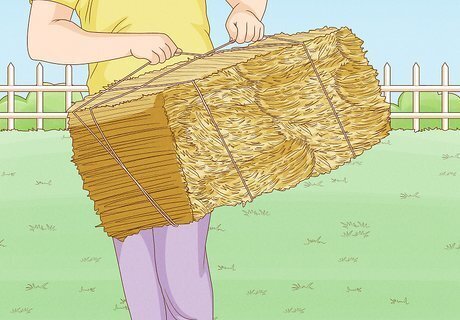
Carry or toss the bale if you're strong enough. You can carry bales manually, but if you have a lot to move, this may not be feasible. Tossing them is hard work, but some people prefer this technique. Toss the bales into the pallet area. If you're working with a partner, don't expect them to catch bales. You'll probably knock them over instead! Toss it so that it'll land near them, not on them.

Move the bale with a dolly for easier transport. A dolly makes moving bales easy for most people. Tip the bale on its end. Lean it about 10 degrees, and then put it on the dolly. Using hay hooks can help stabilize the load.
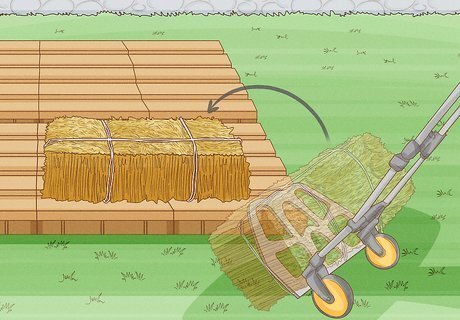
Drop the bale on the floor or pallet. Using the transport method of your choice, move the bales, one by one, to the pallet area for stacking.

Avoid stacking bales that are loose or have broken strings. Twine needs to be snug to keep the bale compact. Bales with loose twine can threaten the stability of the stack. Save them for the top of the stack, or put them aside to be repaired. If you don't have the means to repair it, put it aside to be used as feed right away.

Repair or replace broken twine. Hold down the bale with your knee. Tie a replacement string onto the existing string on the end of the bale. Wrap it around the length of the bale, then tie it at the other end.

Follow a stacking pattern. Be sure to follow a pattern when stacking hay. There are several traditional ones you can try. Make sure the stack height does not exceed 1.5 times the shortest base dimension. Don't stack higher than you can comfortably reach. For example, if the stack is 20 feet (6.1 m) wide and 40 feet (12.2 m) long, the height should not exceed 30 feet (9.1 m). Use Stacking Pattern #1 to create basic four-layer stacks. Use Stacking Pattern #2 to create taller stacks with greater stability.
Using Stacking Pattern #1 for Standard Four-Layer Stacks

Stack the bottom layer "cut side up." Place the bales onto the pallet on their sides with the cut side up. Line them up evenly, side by side, until you fully cover the pallet with a single layer of bales. If stacked properly, the strings will be on the sides, rather than the top and bottom. This allows for better air circulation. When a bale is on its side, the hay stems should run vertically. The top of the bale will feel sharp and jagged.

Stack the second layer "top side up." The second layer needs to be placed perpendicularly to the first, with all the bales placed width-wise. This time, the strings will be on the top and bottom rather than on the side.

Tuck your bales tightly together. You can usually put them loosely in their spot and kick them firmly into place, especially if it's a tight spot. You can also shove the bale in with your knee, which would be safer. Make sure the bales are packed in as tightly as possible. Tightly packing the bales helps prevent unstable stacks. The orientation of the bales (cut side up) allows for circulation. If your bales are still green, pack them in a little more loosely.
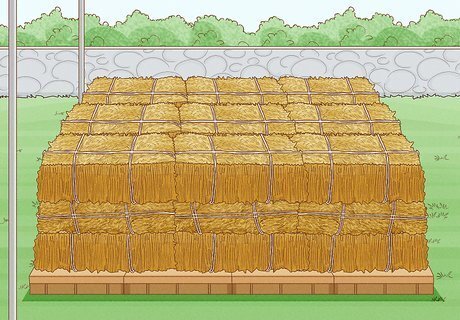
Continue alternating the direction for each layer. Alternating the direction allows for good air circulation and results in very stable stacks. Changing the direction each time locks the bales in together, almost like puzzle pieces, with great stability. This is the simplest and easiest way to stack hay.
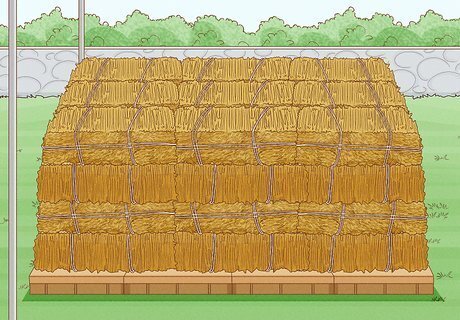
Do four layers total for the most stability. Vertically, the bales will form four-bale columns, and between these columns, the stack can collapse. If your stacks are four bales or fewer, this won't be as much of an issue.

Fill the pallet to capacity. Cover the pallet with the first layer, then start building stacks from the corners toward the middle. Make sure to keep the corners or each new stack perfectly lined up with the corners below to assure stability.
Using Stacking Pattern #2 for Taller Stacks

Put a bale in the corner width-wise. Position this first bale top side up. The strings will be on the top and bottom rather than on the side. Start in the far left corner and work from left to right.

Stack two bales next to it lengthwise. Position these bales "cut side up." The string will be on the sides. Place these side by side, since you're currently creating the first layer.

Continue stacking the bales length-wise. Keep going until you get to the wall or the edge of the pallet.

Stack the other corner bale width-wise. This corner bale will be top side up. It finishes off a row that runs from left to right. To make the corner sturdy, make this two bales thick. The first (far left) corner was one bale thick. This (far right) corner is two bales thick. This begins the interlocking pattern, as opposed to the regular vertical stacking of Pattern #1.

Stack the next row two bale widths thick. This row is in front of the corner bale (closer to you) with ALL the bales lengthwise.

Stack the next row after that just like the first. Repeat the exact same placement as before.

Follow the same pattern for the second layer. This time, though, it is flipped on its side. Put a bale in the corner lengthwise, then stack a row of two bales in front of it width-wise, etc.

Start the next layer like the first and continue alternating patterns. While difficult to get used to, this pattern will maximize stability by crossing bales over each other perpendicularly and thus "locking" them together. Use this method to make very high stacks (4+ layers). It can help prevent your stacks from collapsing and ensure the safety of those working around them.



















Comments
0 comment